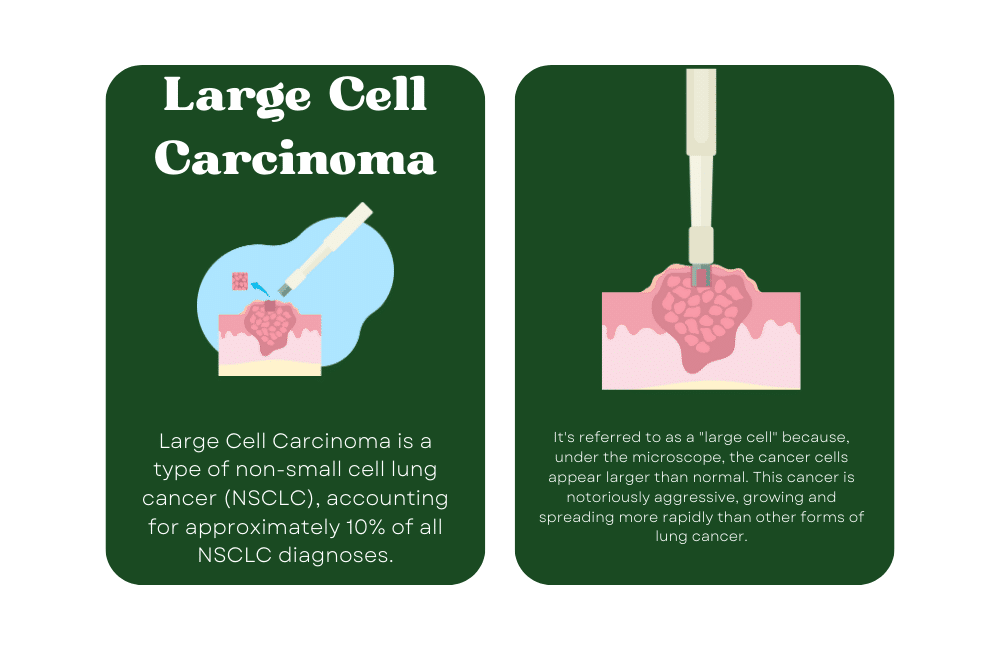Large Cell Carcinoma is a significant health concern that many may have heard of, but few truly understand. This article aims to provide an in-depth look into Large Cell Carcinoma—what it is, its common symptoms, the available diagnostic procedures, and the current treatment options.

As we venture into this topic, we hope to shed light on this medical condition that impacts numerous lives worldwide.
What is Large Cell Carcinoma?
Large Cell Carcinoma is a type of non-small cell lung cancer (NSCLC), accounting for approximately 10% of all NSCLC diagnoses. It’s referred to as a “large cell” because, under the microscope, the cancer cells appear larger than normal. This cancer is notoriously aggressive, growing and spreading more rapidly than other forms of lung cancer.

This condition primarily affects the lungs’ outer regions, though it can manifest anywhere within them. Due to its rapid growth and the often-late discovery, Large Cell Carcinoma presents a considerable health challenge, making early detection and treatment paramount.
Spotting the Symptoms of Large Cell Carcinoma
Large Cell Carcinoma, like other types of lung cancer, can be insidious in its onset. Symptoms often mimic less severe respiratory conditions, making it a challenging condition to identify in the early stages. In this section, we delve into the common symptoms of Large Cell Carcinoma, encouraging readers to watch potential warning signs.

Persistent Cough
A persistent cough is one of Large Cell Carcinoma’s earliest and most common symptoms. While a cough is typically associated with common colds or allergies, a cough that doesn’t improve over weeks or worsens may signify a more serious condition like Large Cell Carcinoma.
Shortness of Breath
Shortness of breath or difficulty breathing is another typical symptom. Patients often gasp for air during activities that previously caused no trouble. This can be due to the tumor obstructing air passages or damaging lung tissue.
Chest Pain
Chest pain that worsens with deep breathing, coughing, or laughing can indicate Large Cell Carcinoma. As the cancerous cells proliferate, they can cause discomfort and pain in the chest area. However, chest pain can also be a symptom of numerous other conditions, so seeking medical advice for a proper diagnosis is crucial.

Unexplained Weight Loss and Fatigue
Cancer often triggers systemic responses in the body. Patients may experience significant weight loss without changes in diet or exercise routines. They might also feel persistently tired or fatigued, despite adequate rest. These systemic symptoms are the body’s response to fighting off cancerous cells and can indicate the presence of Large Cell Carcinoma.
Hemoptysis: Coughing Up Blood
Coughing up blood, also known as hemoptysis, is a more severe symptom that requires immediate medical attention. This symptom may suggest that the disease has advanced and is causing damage to lung tissues and blood vessels.
Although these symptoms can be associated with other less serious conditions, they can also indicate the presence of Large Cell Carcinoma, particularly when multiple symptoms occur simultaneously. It is crucial, especially for individuals with high-risk factors, such as a history of smoking or advanced age, to have regular check-ups. Early detection dramatically improves the prognosis and treatment outcomes of Large Cell Carcinoma, underlining the importance of being attentive to changes in your health.
Unraveling the Diagnostic Process of Large Cell Carcinoma
The journey toward diagnosing Large Cell Carcinoma is a comprehensive process, integrating various investigative methods. This section provides a more detailed look into the steps involved, offering insights into how physicians arrive at a definitive diagnosis.
Physical Examination and Medical History Review
The first step towards diagnosis typically involves a thorough physical examination. During this examination, physicians look for general signs of health and any unusual signs, such as breathing difficulties or unusual lung sounds, that might suggest a lung-related issue.
A detailed medical history is also reviewed. This includes asking about symptoms, personal and family history of lung cancer, and exposure to environmental risk factors such as tobacco smoke, radon, asbestos, and more. This step is vital as it helps narrow down potential issues and assists physicians in assessing the risk factors and the need for further tests.
Imaging Tests
If the physical examination and medical history review suggest the possibility of lung cancer, the next step is usually diagnostic imaging. Chest X-rays are commonly the first imaging test performed. However, while X-rays can show masses or abnormal fluid collections, they do not provide a detailed view of the lungs.
Therefore, a Computed Tomography (CT) scan is often ordered. CT scans offer a more detailed cross-sectional view of the lungs and can detect smaller lesions that might not be visible on a regular X-ray. Occasionally, a Positron Emission Tomography (PET) scan determines if cancer has spread to other body parts.
Biopsy for Definitive Diagnosis
While imaging tests can reveal the presence of abnormal masses, a biopsy is necessary to confirm the diagnosis. During a biopsy, a small sample of lung tissue is collected. This can be done through several methods, including a bronchoscopy, where a tube is passed down the throat into the lungs, or a needle biopsy, where a needle is inserted into the chest wall to collect tissue.
The collected sample is then examined under a microscope by a pathologist. In the context of Large Cell Carcinoma, the pathologist is looking for larger than usual cells, which is characteristic of this condition. If these larger cells are present, a diagnosis of Large Cell Carcinoma can be confirmed.
It is important to note that each patient’s diagnostic process may vary based on their individual symptoms, risk factors, and overall health status. However, understanding these steps can help demystify the process and prepare patients for what to expect.
Treatment Options for Large Cell Carcinoma
Treatment for Large Cell Carcinoma largely depends on the stage of the disease at diagnosis. Here are the common treatment options:
- Surgery: If the cancer is localized and the patient is in good overall health, removing the tumor surgically is often the first choice. Procedures vary from a lobectomy, where a portion of the lung is removed, to a pneumonectomy, which involves removing an entire lung.
- Radiation Therapy: This is often used with surgery or as a standalone treatment for patients who cannot undergo surgery. High-energy X-rays are used to target and destroy cancer cells.
- Chemotherapy: Involves using powerful drugs to kill cancer cells throughout the body. This can be used before surgery to shrink tumors, after surgery to kill remaining cells, or as the main treatment for advanced cases.
- Targeted Therapy and Immunotherapy: These newer options have shown promise in treating certain lung cancers. Targeted therapies attack specific characteristics of cancer cells, while immunotherapy helps the patient’s immune system fight cancer.
Final Thoughts
Large Cell Carcinoma, while less common than other lung cancers, presents unique challenges due to its aggressive nature. Awareness and understanding of the condition are crucial in promoting early detection, timely treatment, and increased survival rates. While the fight against Large Cell Carcinoma—and cancer in general—is far from over, advances in medical technology and treatment offer hope to those impacted by this disease. As we continue to broaden our understanding, the prospect of a cancer-free world becomes increasingly achievable.
FAQs
What is the definition of large cell carcinoma?
What type of cancer is large cell carcinoma?
What causes large cell carcinoma?
It’s essential to remember that not all individuals with risk factors will develop large cell carcinoma, and some people without apparent risk factors may still develop this type of cancer.
Please note that this information is for general understanding and awareness purposes only. If you suspect any health issues or have concerns about lung cancer, it is crucial to consult a healthcare professional for accurate diagnosis and personalized guidance.

